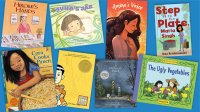Navigating Asian and American Identities
Eight books with Asian Pacific American protagonists can help foster rich dialogues in our diverse elementary schools.
Your content has been saved!
Go to My Saved Content.Books are like mirrors, providing readers with opportunities to see themselves in their pages, slaying dragons, braiding hair, searching for buried treasure. When children read books that are relevant to their lived experiences, they become more motivated to read and to use their background knowledge to better comprehend texts. It is therefore important for educators to incorporate culturally relevant books in their classrooms, so that all children can see positive representations of themselves in books.
Books are also like windows, putting readers into the shoes of people whose lives are different from their own. Through culturally relevant literature, children are given access to the customs and norms of other cultures, which helps cultivate principles of tolerance and acceptance. In today’s diverse classrooms, this is critically important.
To provide mirrors and windows on the Asian Pacific American experience, I’d like to recommend several books that reflect these cultures and feature children who navigate Asian and American identities. These books are recommended by educators, the Social Justice Books initiative, the Asian/Pacific American Librarians Association, School Library Journal, and the CUNY-NYS Initiative on Emergent Bilinguals. They represent cultures from various Asian Pacific nations, capturing only parts of the lived experiences of Asian Pacific American children. But they’re a start.
Kindergarten to Second Grade
Juna’s Jar by Jane Bahk (Korean American): Juna and her friend, Hector, love collecting things in empty jars usually used to store kimchi, the spicy pickled vegetable dish that is a fixture at every Korean meal. Then Hector moves away, leaving Juna brokenhearted. She turns to her special kimchi jar for help and goes on adventures each night. This book celebrates imagination and cross-racial friendships, and features beautiful watercolor illustrations by Felicia Hoshino.
A Different Pond by Bao Phi (Vietnamese American): Early in the morning, Bao Phi and his father go on a special fishing trip in a small pond in Minneapolis to catch fish for their family to eat. Between catches, Bao’s father tells exquisite stories of a different pond—one in their homeland of Vietnam. In a book illustrated by Thi Bui, Bao Phi delivers the story of an immigrant family that honors its past while navigating a new home.
The Ugly Vegetables by Grace Lin (Chinese American): As a young girl, Grace Lin wished for a garden full of bright, colorful flowers instead of the bumpy, ugly vegetables that her Chinese mother would plant. Lin covets her neighbors’ gardens, filled with blossoming flowers. But the Chinese vegetables are eventually harvested and put into a soup for everyone to enjoy, showing that everything has its own beauty and purpose.
Cora Cooks Pancit by Dorina Lazo Gilmore (Filipino American): Little Cora loves helping her mother in the kitchen. When her siblings are out one day, Mama lets Cora make whatever she wants. She ambitiously decides to prepare her favorite Filipino noodle dish, pancit, shredding the chicken, soaking the noodles, stirring them in the pot, and then surprising her siblings with her grown-up cooking. This book, illustrated by Kristi Valiant, captures a loving relationship between mother and daughter, and there’s a teacher’s guide.
Third to Fifth Grade
Amina’s Voice by Hena Khan (Pakistani American): Amina is a Muslim girl who tries to balance family, friendships, religion, aspirations, and what it means to be Pakistani American. The 11-year-old contemplates changing her name—her best friend, Soojin, is thinking of changing her name to something that sounds more “American.” Amina is devastated when her local mosque is vandalized, but learns to appreciate her community as she sees people come together.
Hiromi’s Hands by Lynne Barasch (Japanese American): Hiromi Suzuki is a Japanese American girl in New York City whose family runs a Japanese restaurant. After begging her father to bring her to the fish market and to teach her how to make sushi, Hiromi grows up to become one of the first women in the male-dominated world of sushi chefs. Hiromi’s Hands is based on a true story and includes a glossary and pronunciation guide.
Step Up to the Plate, Maria Singh by Uma Krishnaswami (Indian American): Maria Singh is a 9-year-old girl who wants to play softball in the first all-girls’ team in Yuba City, California, in 1945. However, her Mexican Mamá and old-fashioned Punjabi Papi don’t believe girls should play sports. As her family is subject to prejudice and discriminatory laws and encounters other hardships, Maria learns to step up and find her voice in an unfair world.
American Born Chinese by Gene Luen Yang (Chinese American): This comic tells three apparently unrelated stories: Jin Wang, the only Chinese American kid in his school, wants to be an all-American boy; the famous Monkey King masters the art of kung fu but has no place in heaven; and Chin-Kee, a kid who displays all the negative stereotypes of Chinese people, ruins his cousin Danny’s reputation at school. The stories of these characters come together in the end with an unexpected twist.
